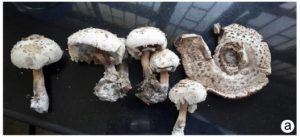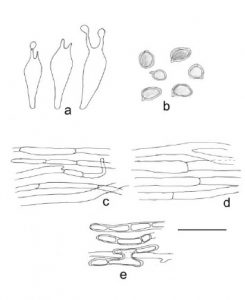Chlorophyllum nothorachodes Vellinga & Lepp, in Vellinga, Aust. Syst. Bot. 16(3): 363 (2003) Index Fungorum number: IF 628861
Pileus 6.0–14.0 cm wide, oval when young, then becoming convex, creamish with dark brown raised squamules present in concentric manner that are more concentrated towards centre, flesh thick, margins striated. Gills crowded, free, white then turned greyish, broad. Stipe upto 8 cm long and 2.0 cm broad white, becoming brown on bruising, broad from the base. Annulus present, double ridged, detachable, white. Edibility non-edible.
Basidia 27.2–32.0 × 9.6–11.2 μm, hyaline, clavate. Sterigmata 4.0–6.4 μm long. Basidiospores 8.0–10.4 × 5.6–7.2 μm, ellipsoid, olive green, double walled, monoguttulated. Pileus context hyphae 8.0 μm wide, inflated up to 28.0 μm, hyaline, branched, septate. Stipe hyphae 4.0–28.0 μm, hyaline, branched, septate. Annulus hyphae 4.0–12.0 μm wide, dimitic.
Material examined : India, Jammu & Kashmir, Jammu, Bajalta, gregarious, humicolous, 15 Sept 2015, Roshi Sharma & Y.P. Sharma, HBJU 410.
Distribution: Known from U.S.A and India.
Notes: Current species is found to be a new addition to the existing mycobiota of Jammu & Kashmir State. The species was first described by Vellinga in the year 2003 having large sized caps covered with brown coloured squamules, closely crowded gills and thick walled basidiospores. Recently, this species has been reported from Southern India by Priyamvada et al. (2017).
FIGURE. a Young and mature basidiocarps of Chlorophyllum nothorachodes.

FIGURE. Chlorophyllum nothorachodes a) basidia b) basidiospores c) pileus context hyphae d) stipe context hyphae e) annulus hyphae. Scale bars: a-e = 15 μm.

